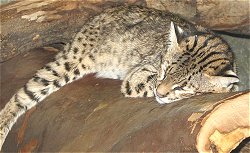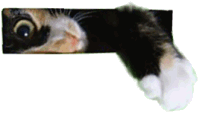Geoffroy's Cat

The Geoffroy's cat is a small feline species from South America. It is found throughout the southern part of the continent east of the Andes. Some Geoffroy's have been found as far south as cold and wintry Straits of Magellan, which makes them, along with the Puma, the most southerly of the world's native cat species. The cats get their somewhat unusual name from French naturalist Etienne Geoffroy St Hilaire, who in the 19th century identified the cat as a distinct species.
Geoffroy's cats are the size of small domestic cats, with the cats that live further north being somewhat smaller than those in Southern Argentina and Patagonia. The Geoffroy's usually weighs 4 to 13 pounds (1.8 - 5kg), with males being larger and heavier than females. Like a small domestic cat they stand 6 to 10 inches (15- 25cm) high at the shoulder. The base fur colouration depends on where the cat is found, since evolution has caused the cats to develop coats appropriately coloured to their native terrain. Northern Geoffroy's Cats have a ground colour of reddish/yellow fur, while cats in the south have a grey base colouration. Between these two extremes there is considerable variation in coat colours throughout the other parts of the Geoffroy's homeland. The camouflage is badly needed. Not because the cats have a lot of predators among animal kingdom, (actually one could say none), but because they are hunted and killed in large numbers by humans. Sadly, their beautiful fur means that the Geoffroy's cat is one of the most hunted wildcat species in South America. As many as 150,000 pelts are traded each year. Fortunately, after suffering severely for years at the the hands of trappers, the cats are now being protected by laws restricting the sale of pelts and capture for the pet trade.
The fur which makes the Geoffroy's coat so sought-after is marked by small black spots of equal size, spaced evenly over the body. These spots merge into striped markings around the neck, chest and face. The undersides of the body and chin are lighter and the tail is covered with black bands usually ending in a solid black tip. The backs of the ears are black with a central white spot, except for melanistic (black with black spots) cats which do not have the white on the back of the ears. Melanistic cats are more common in the north and in areas of dense forest.
Perhaps as an evolutionary response to being hunted, Geoffroy's cats prefer thick cover and scrubby vegetation and largely avoid open grassland areas. Like most cats, the Geoffroy's is nocturnal, and hunts mostly at dawn and dusk. The cat is a good climber, and can swim across rivers up to 100 feet (31m) wide even in fast-flowing waters. It also catches frogs in the river, although most of the hunting happens on dry ground. Geoffroy's like to sleep on the lower branches of a tree, where they also prefer to mate. The father hangs around for as long as it takes to finish mating, and leaves the female with the kittens. There are usually 2-3 of these, which are born 75 days after father has said goodbye. (Pregnancy is approximately 10 days longer than for a domestic cat). Kittens at 6 weeks are already excellent climbers.
The home range of Geoffroy cats is relatively small (at least for a wild cat) with a female's home range being about 2.5 km across whilst males range across approximately three times the distance. The cats prey on birds, lizards, insects and rodents and fortunately for Geoffrey's food is generally plentiful.
The Geoffroy's cat is classified under the genus Felis but placed in the species of Leopardus due to differences in the number of chromosomes with the average felis. The Geoffroy's has 36 chromosomes, which is common to all species in the Leopardus and Oncifelis genera - two chromosomes less than other cats including domestic cats (Oncifelis is a genus now incorporated into the Leopardus species and includes the Kodkod, the Geoffroy's smaller and much rarer cousin).
Can Geoffroy's cats be kept as pets?
The answer is yes, but even if you can buy Geoffroy's kitten, think hard before you do so. Besides the ethics of forcing a wild animal to live in the restricted area of your home, there are other considerations like 'home proofing' and training. Geoffroy's can be trained to use a litter tray or even walk on the leash, but you have to start early. They are very mobile and energetic creatures which will spend a large chunk of their waking time running and jumping - which they do at full speed (which is very fast) and irrespective of obstacles on their path. So 'home proofing' means not only mean removing expensive china from the shelves and tops of the cupboards but also padding furniture so the cat can't get injured when hurtling into it. A domesticated Geoffroy's can get attached to people, but they never bond with more than one or two humans and may need to be prevented from shredding the rest if 'provoked' by for example, a sudden movement. Even when a visitor is being as unthreatening as possible, the Geoffroy's will at least spend the visit growling ferociously from under the sofa, and may get yet more aggressive. Finding a cat seater when you want to go on holiday may be a challenge.
If you do want a milder Geofroy's, consider a Safari cat. Safari cat is a 'F1 hybrid' between a Geofroy's and a domestic cat. Unlike the militant Geoffroy's these are said to be delightfully gentle creatures. They are also very rare and expensive. They are two major difficulties in breeding Safaris: the longer gestation period of the Geofroy's means that when they are bred with domestic cats the kittens are often born prematurely and need special care; and an unexpected effect of the different number of chromosomes between a Geofroy's and a domestic cat is that F1 Safari carry an odd number of chromosomes (37) which appears to considerably increase the size of both kittens and adult cats. So a four to six pound female Geoffroy cat can produce a 25+ pound (11-12kg) offspring. Most of the kittens have to be hand-raised because they require much more food than the mother can supply.

